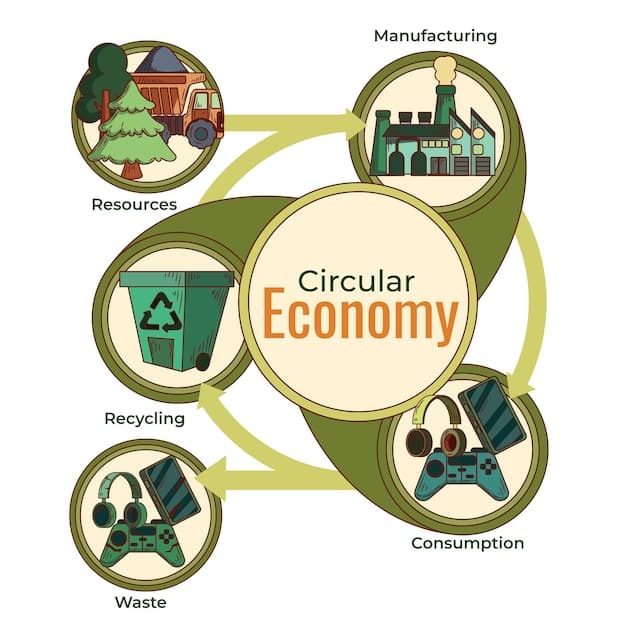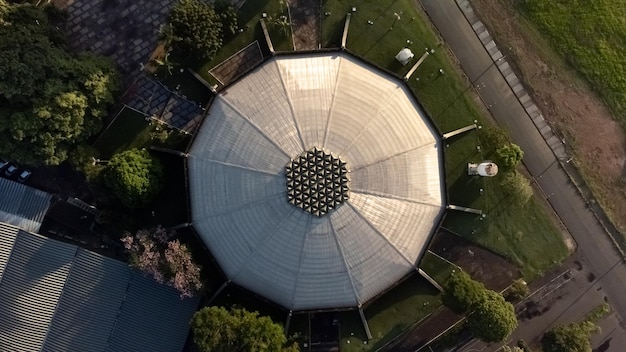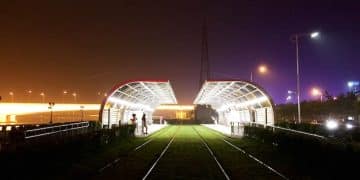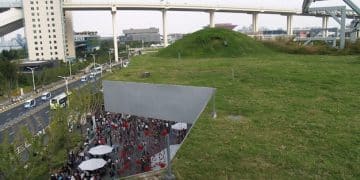FIFA Sustainability: US Stadiums Meeting 2026 Environmental Standards

Achieving FIFA’s ambitious environmental targets by 2026 requires US stadiums to implement comprehensive sustainability strategies, focusing on energy efficiency, waste reduction, water conservation, and green infrastructure to ensure the upcoming World Cup events align with global ecological responsibilities.
As the countdown to the 2026 FIFA World Cup™ officially begins, the conversation extends beyond mere sporting prowess and into the crucial realm of environmental responsibility. FIFA’s Sustainability Initiatives: How US Stadiums Can Meet the New Environmental Standards by 2026 represents a pivotal challenge and an unparalleled opportunity for host cities across the United States. This upcoming tournament is poised to be more than just a global spectacle; it’s set to become a benchmark for large-scale event sustainability, demanding a paradigm shift in how US venues operate and innovate.
The Genesis of FIFA’s Sustainability Mandate
FIFA’s commitment to sustainability is not a new phenomenon, but rather an evolving mandate that has gained significant traction in recent years. Recognizing the immense environmental footprint of global sporting events, the organization has progressively tightened its standards, aiming to mitigate negative impacts and foster a positive legacy. This commitment is particularly acute for the 2026 World Cup, given its expanded format and multiple host nations, necessitating a concerted effort across diverse operational landscapes. The journey toward a greener World Cup began with understanding the complex interplay between sports, environment, and society.
Historical context reveals a gradual awakening within major sports organizations regarding their ecological responsibilities. Early initiatives often focused on basic waste management and recycling. However, as climate science advanced and public awareness grew, the scope of sustainability expanded to encompass a holistic approach, including carbon footprint reduction, water conservation, and responsible sourcing. This evolution underscores a fundamental shift from mere compliance to genuine stewardship, driven by the understanding that a healthy planet is intrinsically linked to the future of sports.
Evolution of FIFA’s Environmental Goals
From modest beginnings, FIFA’s environmental goals have become increasingly ambitious. Initially, the focus was often localized, dealing with immediate operational impacts. Today, the organization emphasizes a lifecycle approach, considering everything from stadium construction and transportation to spectator behavior and post-event legacy. This broader perspective acknowledges that true sustainability requires systemic change, integrating environmental considerations into every facet of tournament planning and execution.
- Early Stages: Primarily focused on waste and recycling programs at venues.
- Mid-Period: Introduction of carbon offsetting programs and basic energy efficiency measures.
- Current Mandate: Comprehensive approach covering energy, water, waste, climate, procurement, and community engagement.
- 2026 Vision: A net-zero carbon tournament with significant social and environmental legacy benefits.
The push for these heightened standards reflects a global urgency to address climate change and resource depletion. FIFA, as a major global entity, recognizes its role in driving positive change, leveraging its immense platform to promote sustainable practices. This commitment is not merely symbolic; it translates into concrete requirements and measurable targets for host cities and their venues, influencing infrastructure development and operational protocols. The objective is to ensure that the tournament not only entertains but also inspires and educates.
Understanding the historical progression of FIFA’s sustainability efforts provides a crucial backdrop for appreciating the current demands placed on US stadiums. It’s a narrative of continuous improvement, driven by scientific understanding, stakeholder expectations, and a growing recognition of the interconnectedness between sports and environmental health. The 2026 World Cup represents a confluence of these evolving mandates, setting the stage for a truly transformative event.
Key Environmental Standards for 2026: What US Stadiums Face
The environmental standards set by FIFA for the 2026 World Cup are robust and far-reaching, designed to minimize the tournament’s ecological footprint. US host stadiums are now facing a comprehensive set of requirements that span multiple dimensions of environmental performance. These standards go beyond superficial greenwashing, demanding tangible, measurable actions that demonstrate a genuine commitment to sustainability. Each standard targets specific areas of impact, pushing venues towards innovative solutions and operational excellence.
Compliance with these standards is not optional; it’s a prerequisite for hosting matches. This places a significant onus on stadium operators, city planners, and local authorities to collaborate effectively. The challenge is amplified by the sheer scale of the tournament, with matches spread across numerous cities, each with its unique environmental context and infrastructure. This necessitates a tailored approach, while adhering to the overarching FIFA guidelines. Meeting these benchmarks requires detailed planning, substantial investment, and a willingness to embrace new technologies and practices.
Energy Efficiency and Renewable Energy Integration
One of the most critical aspects of FIFA’s mandate is the drastic reduction of energy consumption and a significant shift towards renewable energy sources. Stadiums are energy-intensive facilities, and addressing this area offers the greatest potential for carbon footprint reduction. The goal is to power operations with clean energy, minimizing reliance on fossil fuels.
- Renewable Energy Use: Installation of solar panels (rooftop or off-site purchases of renewable energy credits).
- LED Lighting: Transition to energy-efficient LED lighting systems throughout the venue.
- Smart Building Management Systems: Implementation of automated systems to optimize HVAC, lighting, and power distribution.
- Energy Audits: Regular assessments to identify and rectify energy inefficiencies.
Many US stadiums are already making strides in this direction, but the 2026 deadline demands an accelerated pace. Incorporating sustainable design principles during renovations or new constructions is essential, ensuring that energy efficiency is built-in from the ground up, rather than an afterthought. This shift not only aligns with FIFA’s goals but also offers long-term operational savings for venue owners.
Waste Management and Circular Economy Principles
Waste generation at large-scale events is monumental. FIFA’s standards emphasize a circular economy approach, moving beyond simple recycling to reduce, reuse, and recover materials in a more systemic way. The aim is to divert as much waste as possible from landfills, fostering a closed-loop system where resources are continually valued and repurposed.

- Zero-Waste Goal: Ambitious targets for diverting waste from landfills through extensive recycling and composting programs.
- Reduction at Source: Encouraging vendors to use compostable or reusable packaging and eliminating single-use plastics.
- Food Waste Management: Composting organic waste and donating surplus edible food to local charities.
- Fan Engagement: Educating spectators on proper waste separation and disposal through clear signage and active communication campaigns.
Achieving these waste management goals requires rethinking procurement, logistics, and operational practices. It also relies heavily on fan participation, making effective communication and easily accessible infrastructure for waste separation crucial. The 2026 World Cup serves as an incentive for stadiums to establish lasting waste management systems that benefit not just the tournament but the community long-term.
Water Conservation and Management
Water is a precious resource, and its efficient use is another cornerstone of FIFA’s sustainability agenda. Stadiums consume vast amounts of water, from irrigation of pitches to public restrooms and concession operations. The challenge for US venues is to identify areas of high consumption and implement strategies that significantly reduce water usage without compromising quality or safety.
- Low-Flow Fixtures: Installation of water-efficient toilets, urinals, and faucets.
- Efficient Irrigation: Use of smart irrigation systems, drought-tolerant landscaping, and rainwater harvesting for pitch maintenance.
- Greywater Recycling: Treatment and reuse of wastewater from sinks and showers for non-potable uses.
- Leak Detection: Regular monitoring and maintenance to prevent water loss from leaks.
Implementing effective water conservation measures often involves initial investment but yields significant environmental and economic benefits over time. Moreover, it demonstrates a commitment to responsible resource management, particularly in regions prone to water scarcity. These standards compel stadiums to innovate, adopting technologies and practices that ensure water resources are managed sustainably.
Sustainable Procurement and Supply Chains
The materials and services procured for a mega-event like the World Cup have their own environmental and social footprints. FIFA’s standards extend to encouraging sustainable procurement practices, ensuring that supply chains are responsible, ethical, and environmentally sound. This means considering the lifecycle impact of all goods and services, from food and beverages to merchandise and construction materials.
- Local Sourcing: Prioritizing locally produced goods to reduce transportation emissions and support local economies.
- Certified Products: Sourcing materials and products that have recognized environmental certifications (e.g., FSC certified wood, fair trade coffee).
- Ethical Labor Practices: Ensuring that all suppliers adhere to fair labor standards and human rights.
- Transparency: Requiring suppliers to provide information on their environmental and social performance.
Sustainable procurement isn’t just about environmental impact; it also encompasses social responsibility. By demanding higher standards from their suppliers, stadiums can drive positive change throughout their supply chains, creating a ripple effect that extends well beyond the tournament itself. This holistic approach ensures that sustainability is embedded at every level of operation.
Strategies for US Stadiums to Achieve Compliance
Meeting FIFA’s rigorous environmental standards by 2026 requires a multi-faceted and strategic approach from US stadiums. It’s not merely about individual actions, but about integrating sustainability into the core operational philosophy of each venue. This transformation demands significant planning, investment, and collaboration, moving beyond temporary fixes to establish enduring green infrastructures and practices. The path to compliance involves both immediate tactical adjustments and long-term strategic overhauls, ensuring that changes are both effective and sustainable post-tournament.
The complexity is compounded by the varying ages, designs, and existing infrastructures of US stadiums. A one-size-fits-all solution is impractical; instead, each venue must conduct a thorough assessment of its current state and identify specific areas for improvement. This assessment forms the basis for a tailored action plan, prioritizing initiatives that yield the greatest environmental impact and align with FIFA’s core objectives. Engaging stakeholders from the outset is paramount to successful implementation, fostering a shared sense of responsibility.
Comprehensive Energy Audits and Retrofits
For many older stadiums, energy inefficiency is a significant challenge. A crucial first step is to conduct comprehensive energy audits to pinpoint areas of excessive consumption. These audits provide invaluable data, guiding targeted retrofits and upgrades that maximize energy savings.
- Professional Audits: Engaging certified energy auditors to assess current consumption patterns, identify inefficiencies, and recommend improvements.
- HVAC System Upgrades: Modernizing heating, ventilation, and air conditioning systems with high-efficiency models and smart controls.
- Building Envelope Enhancements: Improving insulation, windows, and roofing to minimize thermal loss and gain.
- Transition to Renewables: Exploring options for on-site renewable energy generation (e.g., solar panels, wind turbines) or purchasing certified green energy from utility providers.
Investing in energy retrofits not only contributes to FIFA compliance but also results in substantial long-term operational cost reductions. For newer stadiums, incorporating cutting-edge green building technologies from the design phase is equally vital, ensuring optimal energy performance from day one. The emphasis must be on creating a resilient and low-carbon energy infrastructure.
Advanced Waste Management Systems and Fan Engagement
Achieving ambitious waste diversion targets requires more than just adding recycling bins. It necessitates a sophisticated waste management infrastructure coupled with robust fan education and engagement programs. The aim is to make sustainable choices easy and intuitive for everyone attending the matches.
- Centralized Waste Sorting: Implementing advanced sorting technologies and composting facilities within or near the stadium.
- Source Reduction Policies: Working with concessionaires and vendors to eliminate single-use plastics and encourage reusable or compostable alternatives.
- Clear Signage and Collection Points: Strategically placing clearly marked, multi-stream recycling and composting bins throughout the venue.
- Educational Campaigns: Utilizing pre-event communications, in-stadium announcements, and digital platforms to inform fans about waste separation protocols.
The success of waste management initiatives heavily relies on behavioral change. Stadiums must invest in clear and consistent messaging, making it easy for spectators to do their part. Collaborating with local waste management companies and community groups can also enhance collection and processing capabilities, ensuring that diverted materials are properly handled and repurposed.
Implementing Smart Water Management Technologies
Water conservation is increasingly critical, particularly in regions experiencing drought. US stadiums can achieve compliance by adopting smart water management technologies that reduce consumption and promote reuse.
- Smart Irrigation Systems: Utilizing sensors and weather data to optimize pitch irrigation, reducing water waste.
- Rainwater Harvesting: Collecting rainwater from roofs and other surfaces for non-potable uses like landscape irrigation or toilet flushing.
- Greywater Recycling Systems: Treating and reusing wastewater from sinks and showers for non-potable applications.
- Low-Flow Fixtures and Sensors: Installing efficient fixtures in restrooms and sensor-activated taps to minimize water usage.
These technologies not only conserve water but also contribute to significant cost savings. Regular maintenance and leak detection programs are also essential to prevent unnecessary water loss. Embracing a holistic approach to water management ensures that stadiums operate efficiently while respecting local water resources.
Green Building Certifications and Sustainable Sourcing
Pursuing recognized green building certifications, such as LEED (Leadership in Energy and Environmental Design), demonstrates a stadium’s commitment to holistic sustainability. Additionally, prioritizing sustainable procurement ensures that the entire supply chain aligns with environmental and social best practices.
- LEED Certification: Pursuing or upgrading to LEED certification for existing structures or new constructions, covering areas like sustainable sites, water efficiency, energy and atmosphere, materials and resources, and indoor environmental quality.
- Local and Seasonal Sourcing: Prioritizing food and beverage suppliers who source ingredients locally and seasonally, reducing transport emissions and supporting local economies.
- Eco-Labeled Products: Opting for cleaning supplies, paper products, and other consumables that carry recognized environmental certifications.
- Fair Labor Practices: Ensuring that all contractors and suppliers adhere to ethical labor standards and human rights.
These strategies combined create a comprehensive roadmap for US stadiums to not only meet FIFA’s 2026 environmental standards but to also establish a lasting legacy of sustainability. This transformation is an investment in both the future of sports and the health of the planet.
Technological Innovations Driving Stadium Sustainability
The rapid advancement of technology plays a pivotal role in enabling US stadiums to meet FIFA’s stringent environmental standards. From smart building management systems to innovative materials and data analytics, technological innovations provide the tools necessary for optimizing resource consumption and minimizing environmental impact. These advancements move stadiums beyond basic green practices into an era of hyper-efficiency and real-time environmental monitoring. Embracing these technologies is not just about compliance; it’s about future-proofing venues and enhancing operational efficiency well beyond 2026.
The integration of digital solutions transforms stadiums from passive structures into active participants in their environmental performance. Real-time data collection and analysis allow operators to identify inefficiencies, predict consumption patterns, and implement targeted interventions. This proactive approach significantly enhances resource management, ensuring that every kilowatt-hour, gallon of water, and pound of waste is accounted for and optimized. The goal is to create smart, responsive venues that operate in harmony with ecological principles.
Smart Building Management Systems (BMS)
Modern stadiums are increasingly relying on sophisticated Smart BMS to centrally control and optimize various building systems. These systems integrate HVAC, lighting, security, and energy management, allowing for unparalleled efficiency.
- Centralized Control: Real-time monitoring and automated adjustment of lighting, temperature, and ventilation based on occupancy and external conditions.
- Predictive Analytics: Using data to forecast energy demand, allowing proactive adjustments and preventing waste.
- Fault detection: Identifying system malfunctions or inefficiencies instantly, reducing energy loss and maintenance costs.
The ability of a BMS to respond dynamically to real-world conditions significantly reduces energy consumption, making it a cornerstone of sustainable stadium operations. It allows for detailed reporting, demonstrating compliance with environmental performance targets and offering insights for continuous improvement.
Advanced Water Recycling and Stormwater Management
Beyond traditional water conservation, modern technologies enable complex water recycling and effective stormwater management, turning potential waste into valuable resources.

- Ultrafiltration and Reverse Osmosis: Advanced filtration systems that allow for the treatment and reuse of greywater from sinks and showers, as well as blackwater from toilets, for non-potable uses.
- Integrated Stormwater Management: Using permeable surfaces, green roofs, and retention ponds to manage rainwater runoff, preventing pollution and allowing for groundwater replenishment or reuse.
- Subsurface Drip Irrigation: Highly efficient irrigation systems for pitches that deliver water directly to the root zone, minimizing evaporation and runoff.
These technologies are crucial for stadiums situated in water-stressed regions, allowing them to significantly reduce their reliance on potable water sources. They represent a closed-loop approach to water management, embodying the principles of a circular economy within the venue.
Waste-to-Energy and Advanced Recycling Technologies
Innovation in waste management extends beyond simple sorting, encompassing technologies that can convert waste into energy or effectively recycle challenging materials.
- On-site Composting Solutions: Accelerated composting systems that quickly process organic waste into nutrient-rich soil amendments.
- Anaerobic Digestion: Converting organic waste into biogas, which can be used to generate electricity or heat for the stadium.
- Advanced Material Recovery Facilities (MRF): Utilizing robots and AI to sort and separate recyclable materials with high precision, improving recycling rates.
These technologies contribute to a truly “zero-waste” ambition for stadiums, ensuring that waste is viewed as a resource rather than a liability. They reduce landfill reliance, minimize transportation emissions, and even create new revenue streams, aligning perfectly with FIFA’s circular economy mandates.
Data Analytics and Reporting Platforms
The ability to collect, analyze, and report on environmental performance data is fundamental to demonstrating compliance and driving continuous improvement. Technological platforms facilitate this crucial aspect of sustainability reporting.
- Environmental Performance Dashboards: Real-time digital dashboards that display key metrics such as energy consumption, water usage, and waste diversion rates.
- Life Cycle Assessment (LCA) Software: Tools that evaluate the environmental impact of materials and processes from cradle to grave, informing sustainable procurement decisions.
- Blockchain for Supply Chain Transparency: Emerging technologies that can track material origins and ethical sourcing throughout the supply chain, ensuring accountability.
By leveraging data, stadiums can not only prove their adherence to FIFA’s standards but also identify new opportunities for innovation and efficiency. This data-driven approach transforms sustainability from a compliance exercise into a strategic advantage, ensuring long-term environmental stewardship.
Potential Challenges and How to Overcome Them
While the vision for sustainable stadiums for the 2026 World Cup is inspiring, the path to achieving FIFA’s stringent environmental standards is not without its hurdles. US stadiums, particularly older venues, face a range of challenges, from financial investment and integrating new technologies into existing infrastructure to fostering cultural change among staff and fans. Overcoming these obstacles requires strategic planning, collaborative efforts, and a long-term commitment to sustainability that extends beyond the tournament itself. Proactive identification of these challenges allows for the development of robust solutions.
One primary concern revolves around the significant upfront capital investment required for major retrofits and technology installations. While these investments often yield long-term operational savings, securing the necessary funding can be a complex endeavor, especially for publicly owned facilities. Another challenge lies in navigating the complexities of existing building codes and regulations, which may not always align seamlessly with the latest green building practices. Furthermore, coordinating efforts across multiple stakeholders—stadium management, city officials, local utility providers, and FIFA—demands exceptional organizational and communication skills. Addressing these challenges head-on is critical for successfully delivering a sustainable World Cup.
Financial Investment and Funding Models
Perhaps the most significant challenge is the substantial financial investment required to upgrade stadiums to meet ambitious sustainability targets. Implementing renewable energy systems, advanced waste management, and water recycling technologies can be costly.
- Public-Private Partnerships: Leveraging partnerships between city governments, stadium owners, and private companies to share costs and expertise.
- Green Bonds and Loans: Exploring sustainable financing options, such as green bonds or loans specifically designated for environmental projects.
- Grants and Incentives: Applying for federal, state, and local grants or taking advantage of tax incentives available for renewable energy and energy efficiency upgrades.
- Return on Investment (ROI) Analysis: Demonstrating the long-term operational cost savings and increased revenue potential from enhanced sustainability to justify initial investments.
A well-articulated business case for sustainability, highlighting both environmental benefits and economic returns, is crucial for securing the necessary funding. This includes reduced utility bills, enhanced brand reputation, and potential for new revenue streams from green initiatives. The World Cup provides a powerful impetus for these investments, offering a clear deadline and global spotlight.
Infrastructure Limitations and Modernization
Many US stadiums are decades old, and retrofitting existing infrastructure with new, green technologies can be complex, expensive, and disruptive. Older buildings may not have the structural capacity or design flexibility for certain sustainable installations.
- Phased Implementation: Breaking down large-scale retrofits into manageable phases to minimize disruption to stadium operations.
- Creative Design Solutions: Working with architects and engineers experienced in sustainable design to find innovative ways to integrate new technologies into existing structures.
- Modular Systems: Utilizing modular renewable energy or waste management systems that can be installed with less invasive construction.
- Long-term Master Planning: Integrating sustainability into the stadium’s long-term development plans, ensuring that incremental improvements build towards comprehensive green infrastructure.
Overcoming these infrastructure limitations requires a clear understanding of each venue’s specific challenges and a willingness to commit to long-term modernization plans. It’s about smart adaptation rather than complete demolition and rebuild, maximizing the use of existing assets while moving towards greener operations.
Behavioral Change and Stakeholder Engagement
Technology and infrastructure are vital, but human behavior is equally important. Encouraging sustainable practices among employees, vendors, and millions of fans is a significant undertaking that requires sustained effort.
- Staff Training Programs: Educating stadium staff and event personnel on sustainable practices, from energy conservation to waste sorting.
- Vendor Contracts: Including sustainability clauses in vendor agreements, requiring them to adhere to specific environmental standards (e.g., zero single-use plastics).
- Fan Education and Campaigns: Launching engaging public awareness campaigns to promote responsible waste disposal, public transport usage, and water conservation among spectators.
- Community Involvement: Partnering with local environmental groups and community leaders to foster a shared sense of responsibility for the tournament’s environmental success.
Effective communication and clear, consistent messaging are critical for encouraging behavioral change. Making sustainable choices easy and rewarding for fans can significantly impact the tournament’s overall environmental footprint. These behavioral aspects are fundamental to creating a truly sustainable event, one where participants actively contribute to the green goals.
By proactively addressing these potential challenges, US stadiums can transform obstacles into opportunities. The 2026 World Cup serves as a powerful catalyst for change, driving investments and innovations that will leave a positive environmental legacy for host cities long after the final whistle blows.
The Long-Term Legacy: Beyond 2026 for US Stadiums
While the immediate focus for US stadiums is to meet FIFA’s environmental standards by 2026, the true measure of success lies in the enduring legacy of sustainability left behind. The World Cup offers a unique opportunity to catalyze long-term change, embedding sustainable practices into the permanent operational fabric of venues and influencing broader urban development. It’s about designing and implementing solutions that continue to deliver environmental and social benefits far beyond the final whistle, establishing precedent for future mega-events and everyday operations alike. The investments and innovations spurred by the tournament should not be fleeting but foundational, creating a greener blueprint for sports and civic infrastructure.
A successful legacy plan considers how the infrastructure upgrades, technological advancements, and behavioral shifts cultivated for the World Cup will serve the community for decades to come. This includes the continued operation of renewable energy systems, the efficiency of waste and water management infrastructures, and the enduring awareness of environmental responsibility among staff and attendees. The aim is to create ‘green’ stadiums that are not just event venues but also models of urban sustainability, contributing to local climate goals and resource conservation year-round. This proactive approach ensures that the environmental dividends of hosting such a prestigious event extend far beyond its duration.
Continued Operational Efficiency and Cost Savings
One of the most tangible long-term legacies will be the sustained operational efficiency and cost savings derived from the sustainability upgrades implemented. Investments in energy efficiency, water conservation, and waste reduction are not one-time expenses; they are long-term assets that reduce utility bills and operational overheads.
- Reduced Utility Bills: Lower energy and water consumption leads to significant ongoing savings, freeing up resources for other priorities.
- Lower Waste Disposal Costs: Increased recycling and composting rates reduce the volume of waste sent to landfills, leading to lower disposal fees.
- Enhanced Asset Value: Sustainable infrastructure and green building certifications increase the market value and attractiveness of the venue.
These financial benefits create a compelling case for stadiums to maintain and continuously improve their sustainable practices long after 2026, solidifying sustainability as a core business principle rather than a temporary trend. The economic dividends reinforce the environmental imperative.
Enhanced Brand Reputation and Community Engagement
Operating a sustainable stadium also significantly enhances the venue’s brand reputation, attracting more events, sponsors, and fans. Furthermore, it fosters deeper engagement with local communities by demonstrating a commitment to environmental stewardship.
- Positive Brand Image: Positioning the stadium as an environmental leader, enhancing its appeal to eco-conscious organizations and fans.
- Attraction of Green Events: Becoming a preferred venue for other sustainable events, conferences, and conventions.
- Community Partnerships: Continuing collaborations with local environmental groups, schools, and non-profits to host educational programs and green initiatives.
- Job Creation: Supporting local green jobs in areas such as renewable energy maintenance, waste management, and sustainability consulting.
A strong commitment to sustainability transforms stadiums into community assets, building trust and showcasing responsible corporate citizenship. This strengthens relationships with local residents and stakeholders, ensuring the venue’s long-term relevance and positive impact.
Influence on Future Sporting Events and Infrastructure Development
The precedent set by US stadiums in 2026 can influence future mega-events globally and shape broader infrastructure development in host cities. The success stories from the World Cup will serve as a blueprint for sustainability in sports and urban planning.
- Best Practice Sharing: Providing case studies and lessons learned for other sports venues and event organizers worldwide.
- Policy Advocacy: Influencing local and national policies towards greener building codes and sustainable urban planning.
- Innovation Hubs: Becoming incubators for further research and development in green technologies applicable to large public venues.
- Citizen Awareness: Raising public awareness about environmental issues and the importance of sustainable living, inspiring individual action.
By demonstrating what’s possible, US stadiums can play a pivotal role in accelerating the global transition to a more sustainable future. The legacy extends beyond the physical infrastructure, encompassing the knowledge, inspiration, and changed mindsets that persist long after the World Cup has concluded. This is not just about hosting a tournament; it’s about pioneering a new era of responsible large-scale events.
| Key Standard | Brief Description |
|---|---|
| ⚡ Energy Efficiency | Reducing consumption and increasing renewable energy use. |
| ♻️ Waste Management | Achieving zero waste through extensive recycling and composting. |
| 💧 Water Conservation | Implementing smart systems to drastically reduce water usage. |
| 🌿 Sustainable Sourcing | Prioritizing ethical and eco-friendly products and services. |
Frequently Asked Questions
▼
FIFA aims for a net-zero carbon tournament by 2026, focusing on substantial reductions in energy consumption, water usage, and waste generation. This comprehensive approach includes promoting renewable energy, implementing robust recycling programs, and advocating for sustainable procurement across all host venues and operations, leaving a positive environmental legacy.
▼
Energy efficiency improvements will involve widespread adoption of LED lighting, installation of solar panels or purchase of renewable energy, and implementation of smart building management systems. These measures are designed to significantly reduce electricity consumption and shift towards cleaner energy sources, minimizing the carbon footprint of stadium operations.
▼
US stadiums are targeting a “zero-waste” goal by implementing advanced recycling and composting programs, eliminating single-use plastics, and encouraging the use of reusable or compostable materials. Fan education and strategically placed multi-stream bins are crucial to divert waste from landfills and promote a circular economy within the venues leading up to 2026.
▼
Water conservation is critical due to the large volume of water consumed by stadiums and increasing global water scarcity concerns. FIFA requires stadiums to install low-flow fixtures, implement smart irrigation for pitches, and explore rainwater harvesting and greywater recycling. These measures aim to significantly reduce potable water consumption and ensure responsible resource management.
▼
The sustainability measures implemented for 2026 are intended to create a lasting legacy of operational efficiency, cost savings, and enhanced environmental performance for US stadiums. They will serve as models for future events, improve community relations, and contribute to broader urban sustainability goals, ensuring these venues remain green for decades to come.
Conclusion
The journey for US stadiums to meet FIFA’s environmental standards by 2026 represents a confluence of ambition, innovation, and responsibility. It’s a challenge that compels host cities to rethink their operational paradigms, embrace cutting-edge technologies, and foster a culture of sustainability that extends far beyond the duration of the tournament. While the path ahead presents its share of complexities, the potential for a transformative impact — both environmentally and socially — is immense. By committing to rigorous energy efficiency, comprehensive waste management, intelligent water conservation, and ethical sourcing, these venues can not only demonstrate their readiness for the global stage but also establish a powerful legacy of environmental stewardship for generations to come. The 2026 World Cup is poised to be more than just a celebration of football; it’s an opportunity for the United States to champion a new era of sustainable mega-events, proving that world-class sports and ecological responsibility can indeed go hand-in-hand.





